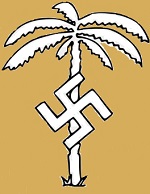Corgi CC60515 German Early Production Sd. Kfz. 181 PzKpfw VI Tiger I Ausf. E Heavy Tank - "Red 131", schwere Panzerabteilung 504, Deutsches Afrika Korps, Point 174, Gueriat el Atach, Tunisia, April 24th, 1943 (1:50 Scale)
"If the tank succeeds, then victory follows."
- Major-General Heinz Guderian, "Achtung Panzer!"
 The German Waffenamt issued an order to design the VK4501(H) (as the PzKpfw VI Ausf E was then known) in May 1941, just one month prior to the commencement of Operation Barbarossa. Interestingly, Henschel und Sohn of Kassel was charged with building the heavily armored chassis while Krupp, by far the largest munitionwerks in Germany, was given the task of developing the turret. The PzKpfw VI Ausfuhrung E (type E) was one of the first German tanks to feature a torsion bar with eight interleaved wheels, which was designed to support the mammoth 57-ton tank. The Ausf E mounted a huge 8.8cm KwK36 L/56 cannon and featured two MG34 machine guns for close support against enemy infantry. By war's end, 1,354 vehicles had been produced, some rolling off the Wegmann assembly line.
The German Waffenamt issued an order to design the VK4501(H) (as the PzKpfw VI Ausf E was then known) in May 1941, just one month prior to the commencement of Operation Barbarossa. Interestingly, Henschel und Sohn of Kassel was charged with building the heavily armored chassis while Krupp, by far the largest munitionwerks in Germany, was given the task of developing the turret. The PzKpfw VI Ausfuhrung E (type E) was one of the first German tanks to feature a torsion bar with eight interleaved wheels, which was designed to support the mammoth 57-ton tank. The Ausf E mounted a huge 8.8cm KwK36 L/56 cannon and featured two MG34 machine guns for close support against enemy infantry. By war's end, 1,354 vehicles had been produced, some rolling off the Wegmann assembly line.
This particular 1:50 scale early production Tiger I Ausf. E heavy tank was attached to schwere Panzerabteilung 504, then deployed to Gueriat el Atach, Tunisia, during the spring of 1943.
Sold Out!
Dimensions:
Width: 2-inches
Length: 4-1/2-inches
Release Date: December 2021
 Historical Account: "Enter the Tiger" - Although the Allies had become aware of a powerful new German heavy tank from its introduction on the Eastern Front in September 1942, British and Commonwealth forces would not encounter the mighty Tiger I until the final stages of the battles to capture Tunis in April 1943.
Historical Account: "Enter the Tiger" - Although the Allies had become aware of a powerful new German heavy tank from its introduction on the Eastern Front in September 1942, British and Commonwealth forces would not encounter the mighty Tiger I until the final stages of the battles to capture Tunis in April 1943.
Schwere Panzerabteilung 504 was the second Tiger unit to be sent to Tunisia. It was issued 25 PzKpfw III plus two Panzerbefehlswagen Tiger in January, and 18 Tigers, comprising the battalion staff, workshop company, while the 1st tank company arrived in Tunisia on March 12th, 1943. Interestingly, the 2nd company remained in Sicily to help defend the island should Tunisia fall to the advancing Allid armies. The tank company had four platoons, each with two Tiger I tanks and two Pzkpw III support tanks. All of schwere Panzerabteilung 504's Tigers were destroyed or captured. The surviving elements surrendered on May 12th, 1943.
During heavy fighting around Guriat el Atach, in Tunisia, one Tiger tank was abandoned by its crew and captured by British troops, who defended their impressive prize until it could be recovered and repaired. Highlighting the significance of this acquisition, Tiger "131" was later inspected by both King George VI and Winston Churchill and would become the most famous fighting vehicle in the world.





 Tiger tank
Tiger tank 


